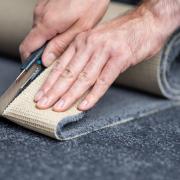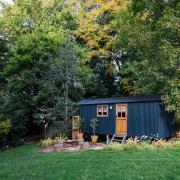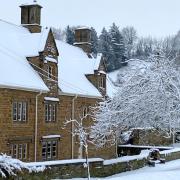Historic England’s Head of Historic Building Climate Change Adaptation Morwenna Slade, and Rachel Coxcoon, Cotswold District Council’s Cabinet Member for Climate Change and Forward Planning, guide us through the ways to make our homes more energy-efficient.
Our homes provide a significant opportunity to reduce our individual carbon footprint. With 25 million homes already in the UK, the big challenge is how existing properties – especially older houses that may be cold and poorly insulated – can improve their energy performance. Traditional homes in particular require a sensitive approach when adopting energy-efficiency measures. This ensures the best outcome in terms of carbon reduction, while being sympathetic to the building’s fabric and inherent character.
The rolling Cotswolds landscape and its beautiful and distinctive honey-toned buildings encapsulate the very essence of English country living. Yet caring for older buildings and making them more energy efficient can often be seen as a challenge.

In fact, these rural ‘gems’ represent a perfect example of where environmental and heritage conservation can work hand in hand. Pre-dating 1919, these traditional, typically solid wall and single-glazed buildings are the epitome of sustainability. Constructed before the carbon hungry lifestyles we know today, many of the materials used would have been worked on site and sourced within a 30-mile radius. Built by hand, these unique buildings have survived for centuries and their continued use and enjoyment is fundamental to living sustainably now and in the future.
Using local labour and materials is as important today as it ever was; not just to ensure that renovation works blend with and compliment the buildings of the past, but also as a significant step in lowering our carbon emissions through the reduced travel miles of construction materials. Traditionally crafted products are worth the financial investment. Not only do they keep the character of our homes alive, they support the essential specialist trades and skills that might otherwise be lost while offering quality and longevity that can be hard to find in factory-made equivalents.
With around a fifth of all UK carbon emissions coming from our houses, improving energy performance through retrofit measures and cutting our energy use, are areas we must all act on if we are to protect the environment and our planet. Small changes add up to a big impact and there is no need to tackle the larger projects all at once. Planning when the bigger jobs should be done, and ensuring they are the most effective choice, is a good place to start.
Here are some of the key ways to tackle the climate emergency at home:
-
Maintain your roof and gutters. Damp walls lose heat faster, meaning it will take more energy to heat your home. Ensuring gutters and downpipes are clear and running freely will protect your building from becoming wet. If your guttering is at the end of its life consider replacing it with guttering of a higher capacity, so as spells of heavy rain increase with our changing climate, your walls stay dry and warm. Ensure your below ground drainage is working well too, as this can have huge impact on how dry a living space is.
Kitchens and bathrooms should be fitted with ventilation, making sure that it is adequate for the room size (Image: Getty Images/iStockphoto)
-
Improve your ventilation. Proper ventilation ensures your home stays dry and your insulation works effectively. Kitchens and bathrooms should be fitted with ventilation, making sure that it is adequate for the room size. If you go on to insulate you home and increase airtightness, it is essential to consider ventilation to prevent moisture accumulating from activities such as cooking and laundry. Some mechanical ventilation systems will recover the heat that can be lost through ventilation; however, you need to think about the increased energy use of a new system and how this might impact your emissions.
Whatever style of roof you have, there is guidance available from Historic England to help you successfully improve the performance of your roof (Image: Andy Roland/Getty Images/iStockphoto)
-
Insulate your loft. Heat loss through uninsulated roofs can be substantial. Adding loft insulation is a quick win – it is inexpensive, high impact and is simple to fit so should be one of the first things to consider when making your home more energy efficient. If, however, your roof is at the end of its life and needs to be replaced this is a great time to add new insulation. Whatever style of roof you have – from historic Cotswold stone tile to thatch – there is guidance available from Historic England to help you successfully improve the performance of your roof.
Newer-style LED bulbs are far more efficient than their predecessors (Image: Getty Images/iStockphoto)
-
Change your lightbulbs. Newer-style LED bulbs are far more efficient than their predecessors. Using less energy to run and lasting a lot longer, LEDs are much more environmentally friendly so by simply upgrading all the lightbulbs in the house you can save money and take a big step towards a net zero carbon future.
By turning down your thermostat by just one degree you’ll save a whopping 10% of your heating costs (Image: Getty Images/iStockphoto)
-
Keep an eye on the heating. By turning down your thermostat by just one degree you’ll save a whopping 10% of your heating costs which, in an average home, means a saving of £115 per annum (Source: OFGEM). By properly maintaining your heating system and insulating all pipes, you can increase the overall efficiency of your home – helping keep toes warm with a lower cost to both pocket and environment.
Old windows are usually durable, functional and repairable (Image: Jeremy Binger/Getty Images/iStockphoto)
-
Look after your windows. When considering ways to save energy, replacing windows often comes top of the list, however, old windows are usually durable, functional and repairable. Most single-glazed traditional windows can be refurbished, providing an opportunity to support local crafts people and reducing reliance on new materials. You don’t need to replace a window unless it is at the end of its life, when double or triple-glazing can enhance thermal performance of the window. Secondary glazing is also a good option to reduce heat loss and retain characterful traditional features.
When your old boiler needs replacing, consider a heat pump (Image: Getty Images/iStockphoto)
-
Swap your boiler for a heat pump. Many boilers will claim to be environmentally friendly, but while they may be more efficient than old appliances, they will still be using fossil fuels. So, when your old boiler needs replacing, consider a heat pump. This will greatly reduce your carbon footprint as these devices use the natural warmth in the air or ground to heat your home. The toolkit (link follows) has a table so you can see which heat pump could be right for you.
Solar panels may be an investment but in the longer term, they can have a huge impact on your carbon footprint and bills (Image: Getty Images/iStockphoto)
- Install solar panels to generate your own power. Solar panels may be an investment but in the longer term, they can have a huge impact on your carbon footprint and bills. Newer solar panels can also warm your water tanks so not only do you get ‘free’ electricity, you will also get warm water. On traditional roofs, solar panel installation needs to take into account both type of construction and maintenance, and in some cases, installing the panels on a shed, or fence, or a free-standing array in the garden may be a more effective option.
Cotswold District Council and Historic England are currently working together to assess how to provide proactive guidance to those living in listed or protected buildings to make it as easy as possible for homeowners to understand how they can best retrofit homes of high heritage value, without undermining their historic importance.
To help homeowners make changes, Cotswold District Council, along with two neighbouring local authorities – Forest of Dean District Council and West Oxfordshire District Council – has recently published a Net Zero Carbon Toolkit that provides all the information needed to start the journey towards making your home carbon neutral. The toolkit is packed full of easy to follow guidance and is a useful resource for self-builders, small-scale developers and contractors. The Net Zero Carbon Toolkit is available for free download: cotswold.gov.uk/netzerocarbontoolkit
Historic England offers a wide range of guides and webinars that help homeowners understand how their buildings work, how to decide what to do first and how best to look after their home. For detailed information on how to fully retrofit your home and minimise your carbon footprint visit Historic England’s web pages:
historicengland.org.uk/whats-new/statements/statement-on-climate-change-and-sustainability
historicengland.org.uk/services-skills/training-skills/online-training/webinars/technical-tuesdays




































